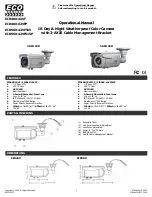
48
Sh
ooting Feat
ur
es
B
Lowering the Flash
Push the flash down gently to lower the flash until it clicks into place when not in use (
C
The Flash Lamp
The flash lamp indicates the status of the flash when you press the
shutter-release button halfway.
•
On: The flash fires when a picture is taken.
•
Flashing: The flash is charging. The camera cannot take pictures.
•
Off: The flash does not fire when a picture is taken.
If the battery level is low, the monitor turns off while the flash is
charging.
C
The Flash Mode Setting
•
The setting varies with the shooting mode.
➝
➝
•
Some settings cannot be used with other functions (
•
The flash mode setting applied in
A
(auto) mode is saved in the camera’s memory even after the
camera is turned off.
C
Effective Range of the Flash
When ISO sensitivity is set to
Auto
, the flash has a range of approx. 0.5–5.0 m (1 ft 8 in.–16 ft) at the
maximum wide-angle zoom position and a range of approx. 1.5–2.5 m (5 ft–8 ft 2 in.) at the
maximum telephoto zoom position.
C
Red-eye Reduction
This camera uses “Advanced Red-Eye Reduction (In-Camera Red-Eye Fix).“
Pre-flashes are fired repeatedly at low intensity before the main flash, reducing the red-eye effect.
Additionally, if the camera detects red eye while saving an image, the affected area is processed to
reduce red-eye before the image is saved.
Note the following when shooting:
•
Because pre-flashes are fired, there is a slight lag between when the shutter-release button is
pressed and when the shutter is released.
•
More time than usual is required to save images.
•
Red-eye reduction may not produce the desired results in all situations.
•
In rare cases, areas of the image that are not affected by red-eye may be processed by red-eye
reduction. In these cases, select another flash mode and take the picture again.
















































